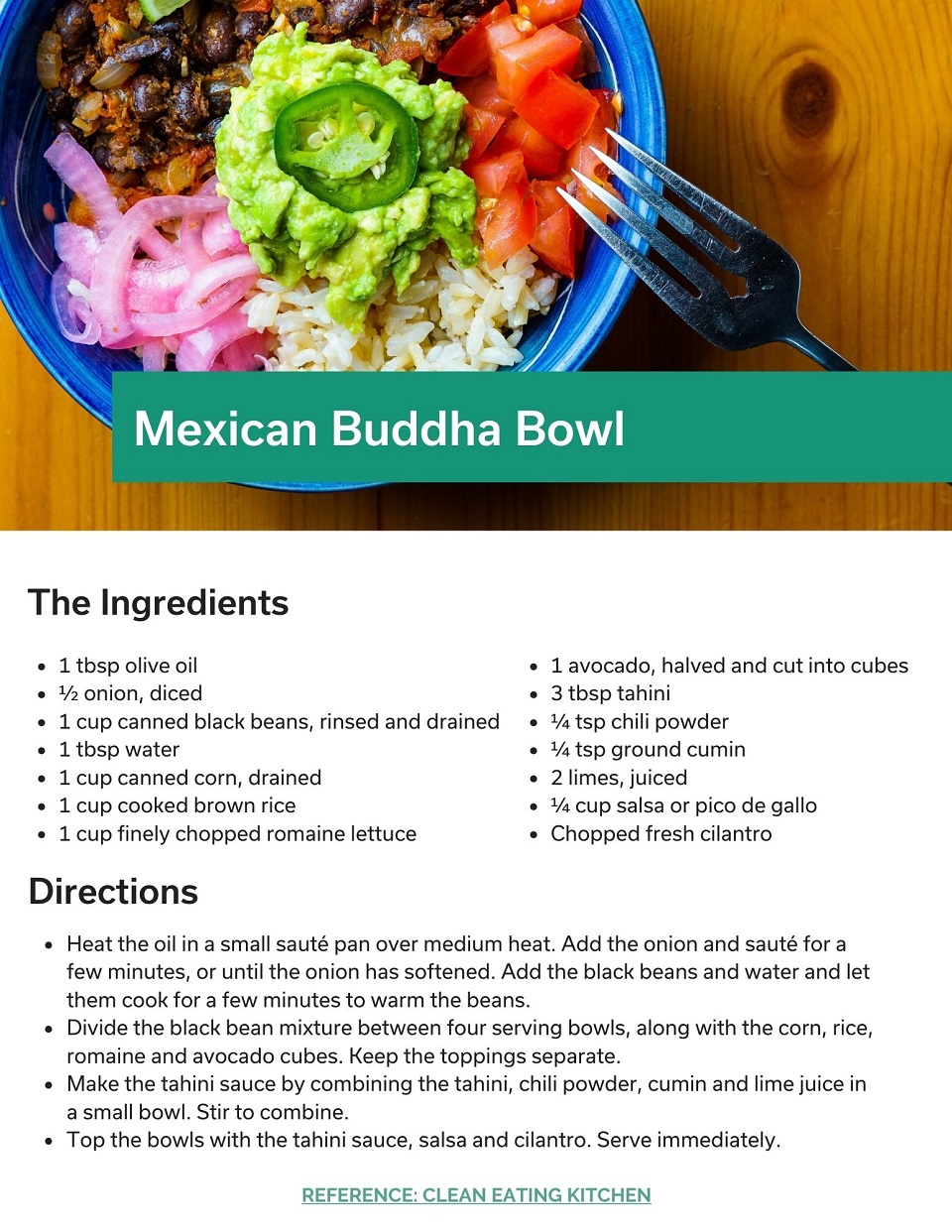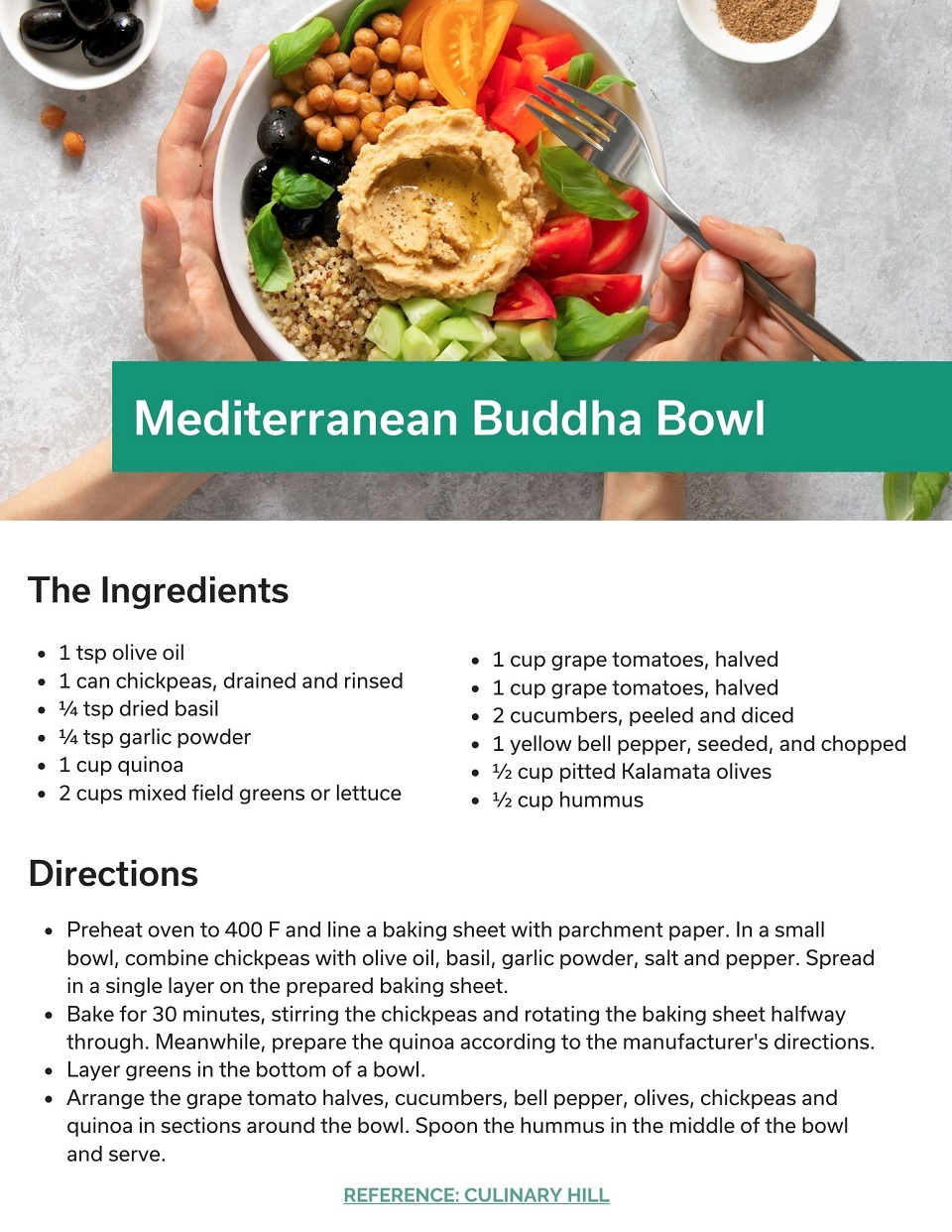How to Build the Perfect Buddha Bowl
Posted in

By now, you’ve probably seen colorful bowls of food, full of vibrant vegetables and sauces that serve as attention-grabbing content on social media. Known as buddha bowls, these dishes have become popular because of both their looks and their purported health benefits for people following plant-based diets. This blog will expand on this latest trend, provide tips on what to include in your bowls and explain why colorful fruits and vegetables matter. We will also provide you with three easy buddha bowl recipes to make at home.
What is a Buddha bowl?
It’s unclear where the name buddha bowl came from, but it has appeared in cookbooks for at least the past decade. Some people believe the round, full bowl of food describes the belly of Budai, a Chinese monk who lived during the 10th century. Other depictions reference Gautama Buddha, the founder of Buddhism. Buddha was known to carry around a big bowl and receive food offerings throughout the day from local villagers.
Regardless of the origin, a buddha bowl is simply a meal that includes little bites of various foods presented separately in a deep-rimmed bowl. There isn’t necessarily a hard and fast rule on what buddha bowls need to be. Instead, it’s a blank canvas to choose the foods you like.
Unlike a pasta dish or a salad where all the ingredients are mixed, the items in a buddha bowl remain independent separate.
Buddha bowls are similar to another type of dish called nourish bowls – however, the main difference is nourish bowls can include animal protein. Buddha bowls are also known as grain bowls, hippie bowls, macro bowls or power bowls.
In general, there are five basic elements to a buddha bowl.
- Whole grains
- Vegetables
- Protein
- Sauce/dressing
- Toppings
How to make a buddha bowl
The beauty of a buddha bowl is that you can use whatever you have in your refrigerator. All you need are a few pantry staples such as rice, beans and lentils.
Here is an overview of which ingredients to include in your next creation.
Grains
These starches provide bulk to the bowl and should come from whole grains, not refined carbohydrates such as white rice. Some examples include brown rice, wild rice, quinoa or barley.
Vegetables
Vegetables can either be roasted or kept raw. For example, roasting bell peppers brings out the natural sweetness, while serving them raw preserves their crunch.
Fresh tomatoes, such as cherry or grape tomatoes, are best raw as are leafy greens – baby kale, arugula or spinach. Other starchy, fibrous vegetables such as butternut squash or sweet potatoes work best when roasted.
Protein
Many Americans assume protein means animal-based products. The truth is plant-based proteins can be equally satisfying and fulfilling.
Beans, chickpeas and lentils serve as the main sources of plant-based protein in buddha bowls. They also add bulk – both to your dish and your stool once digested. Tofu, which is made from soybeans, is also a popular source of protein.
Sauces
Homemade dressings or sauces allow you to limit the amount of sodium, sugar and fat you add to your bowls. It’s easy to use a store-bought sauce that appears to be healthy. Another look at the label may reveal added sugars and enough sodium to meet the daily recommended intake.
Toppings
Nuts, herbs and seeds can add another dimension and layer to your final product. Nuts and seeds contain healthy omega 3 fats, protein and dietary fiber, while herbs offer freshness and added flavor. Sliced avocado and fresh cilantro are two of the most common toppings added to buddha bowls. Other soft herbs work well, too – think parsley, chives, basil or mint.
As for nuts, you can use any type depending on the flavor profile you’re going for. For example, pistachios and almonds complement Mediterranean dishes, while cashews pair well with Asian-style bowls. The most common seeds include flax seeds, chia seeds, sunflower seeds, sesame seeds and pumpkin seeds.
Sauces for buddha bowl
Many sauces and dressings are high in fat and calories due to the use of mayonnaise as both a thickener and flavor enhancer. Throw in added sugars to balance the flavors, and sauces can quickly negate any health benefits of buddha bowls.
That’s why the use of peanut butter, tahini, avocado or yogurt have become the go-to choices for buddha bowl dressings.
Typically, one of those four fats are used with herbs, spices and some type of acid (either lemon or lime juice or vinegar) to make smooth, creamy dressings.
For example, a basic tahini dressing consists of 3 to 4 tablespoons of tahini mixed with lemon juice, a clove of garlic and salt and pepper to taste. Thin the dressing out with warm water, as tahini tends to seize up when mixed with other ingredients.
If you don’t like the taste of sesame seeds, use avocado as a base for a quick dressing. Blend an avocado with some water to thin it out, then add fresh cilantro, lime juice and garlic to round out the flavors. You can even get creative by adding spices – chili powder, paprika and cumin are all good choices.
Benefits of eating colorful foods
If there’s one common theme among buddha bowls, it’s the colorful nature of their appearance. Whether it’s ruby red cherry tomatoes or orange sweet potatoes, nearly all buddha bowls resemble colors of the rainbow.
Looks are one thing, but these fruits and vegetables actually serve a purpose – colorful foods are high in phytonutrients, plant nutrients that both give them color and boast various antioxidants, vitamins and minerals the body needs to carry out basic functions.
People who focus on eating colorful foods, such as those in buddha bowls, often refer to it as the rainbow diet. While not an official diet, eating colorful foods full of phytonutrients may help reduce the risk of chronic diseases and help protect against certain cancers, according to Harvard Health.
Here is an overview of the phytonutrients found in various colors:
Red
Lycopene is the most common phytochemical found in red-colored foods, such as tomatoes, bell peppers and watermelon. Lycopene is beneficial for cardiovascular health. Ellagic acid found in strawberries and cranberries; anthocyanins found in raspberries, red cabbage and radishes; and betalains found in beets and swiss chard are also good for the heart and can help fight inflammation.
Orange/yellow
Beta-cryptoxanthin, beta-carotene and alpha-carotene are all phytonutrients found in orange- and yellow-colored foods. These carotenoids convert to vitamin A, which is essential to eye health. Many of these fruits and vegetables also contain vitamin C. Carrots and sweet potatoes are full of beta-carotene, while corn, grapefruit and bell peppers all have lutein and zeaxanthin, two powerful carotenoids that accumulate in the eyes to defend against cataracts and age-related macular degeneration.
Green
Green vegetables are rich in chlorophyll, isothiocyanates and isoflavones. They are known for anticancer properties by inhibiting how carcinogens (substances that promote cancer) interact with your cells. Cruciferous vegetables – mainly leafy greens – such as kale, spinach and collard greens all have powerful antioxidant powers. In addition, leafy greens also contain vitamin K and folic acid.
White/brown
While not the most visually appealing, legumes and alliums are the backbone of buddha bowls and contain many beneficial properties. For example, lentils and beans (black beans, chickpeas or kidney beans) have folate to prevent blood clots and fiber to help you feel full longer. Alliums, on the other hand, have antiinflammatory and antimicrobial properties thanks to the phytonutrient allicin. Onions, garlic, leeks and scallions all contain allicin. Aside from allium vegetables, mushrooms and cauliflower contain anthoxanthins, a type of flavonoid known to help fight against heart disease.
Purple/blue
Anthocyanins, the same antioxidant found in red fruits and vegetables, also is the primary pigment that gives purple and blue foods their color. Anthocyanins have anti-aging properties due to an ability to protect against oxidative stress. They can also help protect against cardiovascular disease, type 2 diabetes and cancer. The most common examples include blackberries, eggplant and plums. Resveratrol is another phytonutrient that provides fruits with a purple or blue hue. Examples include blueberries and purple grapes.
Buddha bowl recipes
If you’re interested in trying a buddha bowl at home but aren’t sure where to start, consider one of these three recipes. Aside from roasting a vegetable or boiling water for rice or quinoa, there isn’t much cooking involved. Instead, most of the focus is on assembly.
Mexican buddha bowl
Think of this as a deconstructed Mexican burrito that is healthier for you. Many of the ingredients are ones you’re likely used to when it comes to Mexican food – black beans, corn, lettuce, avocado, lime, salsa and cilantro. Where this recipe veers a bit is the tahini dressing. Instead of a sour cream or mayo-based sauce, the tahini provides a nutty and creamy contrast to the Mexican spices.
Mediterranean buddha bowl
When you think of chickpeas and Mediterranean food, hummus is usually the first thing to come to mind. Chickpeas, when roasted whole, offer a different experience than when blended up for hummus. This dish does also include hummus as a topping, although you can substitute it for a yogurt-based sauce.
Buddha bowl with red pepper dressing
Whether roasted or served raw, red peppers add a mild and slightly sweet flavor profile to any dish. They also make for a quick and easy dressing. Between quinoa and chickpeas, the base of this buddha bowl is similar to most others. However, the dressing serves as the star by mixing red peppers, olive oil, lemon juice, paprika, cumin and cilantro.
For more lifestyle tips, wellness content and healthy recipes, visit the INTEGRIS Health For You blog.






